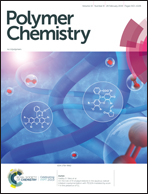Amidation of methyl ester side chain bearing poly(2-oxazoline)s with tyramine: a quest for a selective and quantitative approach†
Abstract
Poly(2-alkyl/aryl-2-oxazoline)s (PAOx) are a class of cytocompatible polymers that have received growing interest over the past decade. This growing interest can mainly be attributed to their greater chemical versatility compared to other cytocompatible polymers, such as poly(ethylene glycol) (PEG), that originate from the diverse set of monomers compatible with the cationic ring-opening polymerization. Within this contribution we focus on the modification of methyl ester functional PAOx, on which we recently reported the quantitative conversion of methyl ester side chain bearing PAOx via direct amidation for a number of amines. While this approach is robust, it can be challenging to introduce certain amines, due to their high cost, poor solubility or additional functionalities. Here we evaluated three alternative amidation approaches of methyl ester side chain bearing PAOx with tyramine in terms of selectivity and quantitative conversion to the respective secondary amides. The amidation proceeded successfully via DMTMM coupling, PFP-activation and TBD catalysis, although only the latter 2 methods selectively yielded the desired product. In summary, we present valuable alternatives to our earlier reported method, contributing further to the biomedical application potential of PAOx.

- This article is part of the themed collection: Polymer Chemistry Lectureship Winners


 Please wait while we load your content...
Please wait while we load your content...